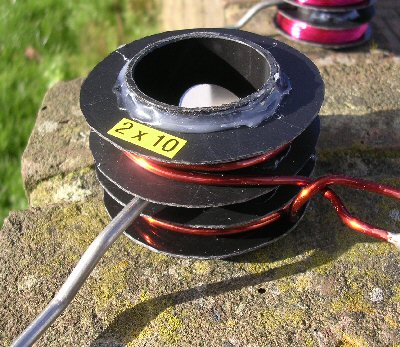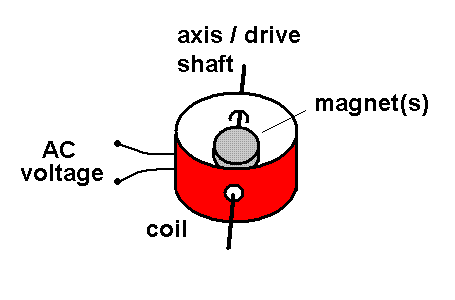Tube / pipe generator


Two versions of the tube gen. The first (left) has 2 x 500 turns (35 SWG) which produces enough voltage to power LEDs while turning the hand crank. The second (right) has 2 x 10 turns (12 SWG) which produces very low voltage but can poduce ca. 5-10 amps while simply cranking the handle.
This is a very simple electrical generator which very neatly demonstrates generation of electricity when the magnets are rotated. Two magnets are attached either side of a simple crank handle. Two coils of wire are situated either side of the magnets and ideally as close to them as possible (i.e the gap between the two sets of coils should be as small as possible). When the crank is turned the magnets induce electricity into the coils - enough to power LED's very brightly.
The generators shown in the pictures use plastic tube of diameter about a = 4cm (see diagram). Discs were cut from sheet plastic and glue-gunned into place and used as formers for the coils. Two small holes were drilled into the pipe to take the crank handle. The magnets were so strong they held themselves in place on the iron crank. The magnets are the same ones used in the shake-a-gen see:
shake-a-gen page

Two versions were made up to show how power could be produced in terms of the current and voltage. The first (top left) has a total of 1000 turns (2 x 500) of 35 SWG and can power a few LED's cranking the handle at a steady slow pace and produces 3 - 4V at ca. 0.2A. The second version (top right) has 20 turns (2 x 10) of 12 SWG. This produces much less voltage (ca. 20/1000 = 1/50th of the 1000 turn gen) and so wont power an LED but because the wire is very thick the internal resistance of the generator is very low. It can therefore produce much higher current than the first. Connecting the second generator to an AC low resistance amp meter showed it produced ca. 10's mV but at 5-10 amps!
Each set of coils will produce an AC voltage so one needs to make sure the coil sets are wired together in series correctly to add the voltages. If you dont get any output from the generator try reversing the connections to only one of the sets of coils. You can also try wiring the coils in parallel to add the currents instead (again, make sure they are wired correctly).
The generator poduces a good sine wave AC voltage and so if two LEDs are wired back to back and across the generator output one LED only will light at any one time depending on the direction of the current (LED are light emitting diodes and so only pass current in one 'direction').

The generator produces voltage when magnets are rotated near to the coils of wire (Faraday Induction). There is no coil current switching so these are AC generators. As long as the magnetic field developed by the magnets does not diminsh too much throughout the volume enclosed by the coils the peak voltage generated by these simple devices is given by:
V = A x N x dB/dT
where V = the peak voltage (V)
A = the cross sectional area of the coils (m²)
N = the number of turns
dB/dT = rate of change of magnetic field strength (T/s)
So for example: if the area A = 0.0013 m² (4cm diameter tube), the number of turns is N = 1000 and the rate of change of magnetic field dB/dt = 4 T/s (1 tesla magnet spinning 4 times a sec) then this will give a voltage of V = 0.001 x 1000 x 4 = about 4 volt (peak).
As these generators have no moving contacts they are very simple, rugged and will work over a very wide range of temperatures. They are water proof and will work when completely immersed in water (as long as the live electrical connections are suitably enclosed). As they have no ferro-magnetic components (except the magnets) they are less efficent than other designs but easier to turn.
STORING THE ENERGY FROM THE GENERATOR - rectifier and storage device
(a simple circuit to make a DC voltage from the generators and so be able to store the energy).
(Please reference this article if using contents elsewhere)
LINKS TO OTHER PAGES:
link to 6 gens page
shake-a-gen page
piezo gen page
nail gen
wave gen
Rough Science hand-cranked gen
Dr Jonathan Hare, E-mail: jphcreativescience@gmail.com
NOTE: Although none of the experiments shown in this site represent a great hazard, neither the Creative Science Centre,
Jonathan Hare nor The University of Sussex can take responsiblity for your own experiments based on these web pages.
THE CREATIVE SCIENCE CENTRE
home | diary | whats on | CSC summary | latest news




